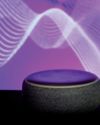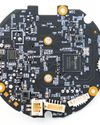
When working with microcontrollers and other digital systems, we don't usually have to be concerned about anything but ones and zeros, right? But sometimes our MCU has to connect to the real world, and that can be messy. Sometimes we have to use that algebra that we couldn't see the need for in high school to make sure that we get the inputs or outputs we want and do it without damaging anything in the process. And in some cases, mesh analysis is how we handle that. I want to show you a few simple mesh circuits, and how they may be calculated and applied in practical scenarios. If you went to EE school, you probably saw this material in a fundamentals of electrical engineering course.
SIMPLE MESH CIRCUIT
Figure 1 shows a simple mesh circuit of three resistors. For a review of resistors, see my article "Getting Started with Resistors" in Circuit Cellar issue 382. Let's say that we need to calculate the voltage across the 2K resistor R2. This is fairly simple to do using series/parallel resistor calculations. R2 is 2K, R3 is 3K, so the value of R2 and R3 in parallel is 1.2K.
The current through R1 plus the parallel combination of R2 and R3 is:
The voltage across the parallel combination of R2 and R3 is:
2.27ma x 1.2K = 2.73 v
So the current through R2 is 2.73V/2K = 1.36 ma.
This simple example illustrates some general principles of mesh circuits:
•The sum of the currents into a node (connection) is zero. The current flowing into the junction of R1, R2, and R3 has to equal the current flowing out. So the 2.27ma flowing in through R1 has to equal the two currents flowing out through R2 and R3. Note that in doing the calculations, you can (and usually do) assume that all currents are positive, flowing into the circuit. When you do the math, at least one will turn negative.
This story is from the October 2024 edition of Circuit Cellar.
Start your 7-day Magzter GOLD free trial to access thousands of curated premium stories, and 9,000+ magazines and newspapers.
Already a subscriber ? Sign In
This story is from the October 2024 edition of Circuit Cellar.
Start your 7-day Magzter GOLD free trial to access thousands of curated premium stories, and 9,000+ magazines and newspapers.
Already a subscriber? Sign In

New TI MCUs Enable Edge AI and Industry-Leading Real-Time Control to Advance Efficiency, Safety, and Sustainability
Texas Instruments (TI) introduced two new series of real-time microcontrollers that deliver advancements to help engineers achieve more intelligent and secure processing in automotive and industrial applications.

Using Amazon Alexa to Control Custom IoT Gadgets
In part two of his article, Brian describes integrating custom IoT gadgets with Amazon Echo using emulation to receive spoken alarms. In part one, he used emulation and Arduino Cloud services as a middleman.

Holiday Hangover Hardware Hacking
Having too much cheer during the holidays? In this month's article, Colin offers a diversion from the jolly season by urging developers to retreat to the basement to brush up on hardware hacking skills. He shows how a low-cost Raspberry Pi Pico and a TP-Link Tapo C200 smart IP camera could become the next automated bird deterrent or a home automation server.

Datasheet: Microamps Per Megahertz Ultra-Low Power MCUs Minimize Current Consumption
How do chip makers differentiate if many ultra-low power MCUs on the market feature the same processor core? The peripherals and different power states offer various ways to manage current consumption down to microamps per megahertz.

Smart Home Lock Down Matter Provides Security Blanket
As more devices in the smart home connect to the Internet, they become increasingly vulnerable to outside attacks. Developers can now add the latest security measures to their Smart Home devices through Matter.

Basic Pulse Circuits
In part one of a three-part series, Wolfgang wrote how basic pulse circuits help digital circuits, such as embedded boards with ARM processors, deal with pulse trains or bursts of pulses from the outside. In Part 2, he dives into enabling flip-flops, timing parameters, and synchronization, design tasks needed to capture, detect, and filter pulses.

Building a Wi-Fi Router Watchdog
Dev created a watchdog for a Wi-Fi extender using a Raspberry Pi Pico. This monitors Wi-Fi connectivity for his smart home lighting system, which would require a reset twice a year due to rapid power interruptions.

Create Your Own PCBs with a CNC Milling Machine
Using KiCad, CopperCAM, and Candle Software

Performance Bottlenecks in Embedded Linux Solutions Analysis, Identification, and Mitigation
Good performance is a requirement for every technology, and system designers rely on operating systems to ensure fast and smooth transitions in critical applications. Fortunately, Pedro writes, the embedded Linux OS offers ways for finding, analyzing and mitigating performance bottlenecks so embedded systems can deliver the speed and efficiency that end users expect.

Renesas New RA8 Entry-Line MCU Groups Brings High Performance of Arm Cortex-M85 Processor to Cost-Sensitive Applications with Market-Leading CoreMark Performance
Renesas Electronics Corp., a premier supplier of advanced semiconductor solutions, introduced the RA8E1 and RA8E2 microcontroller (MCU) groups, extending the industry's most powerful series of MCUs.